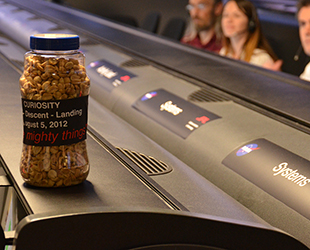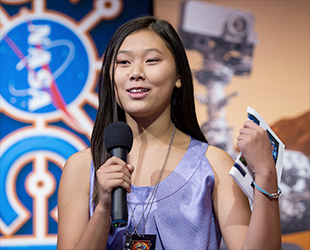August 5, 2012 — On NASA's long checklist leading up to Monday's (Aug. 6) early morning landing of its Curiosity rover on Mars, most of what is remaining to do is handled completely by the spacecraft's on board computers.
The 1:31 a.m. EDT (0530 GMT) touchdown at Gale Crater will require the Mars Science Laboratory (MSL) spacecraft that is carrying Curiosity to slow itself down from a blazing 13,000 miles per hours to just 2 miles per hour (21,000 to 3 kilometers per hour) to safely deposit the nearly one-ton, six-wheeled rover on the surface.
To do so, MSL will need to autonomously fire thrusters to steer through its entry into the Mars' atmosphere, deploy a supersonic parachute, fire eight retro-rockets and then, as it hovers 66 feet (20 meters) above the Martian surface, lower Curiosity on cables — a "sky crane" — to a landing. The descent stage will then need to safely separate from the rover, flying to a crash landing at least 500 feet (150 meters) away.
Back on Earth, at NASA's Jet Propulsion Laboratory (JPL) in Pasadena, Calif., the MSL flight team will have little to do but wait for signals from the rover — relayed through another NASA spacecraft orbiting Mars — to confirm that each critical stage of the entry, descent, and landing has gone as expected.
That, and eat peanuts.
Lucky legumes
Per the flight director's checklist, about an hour before the scheduled landing (based on the time that the signal from the rover will reach Earth, about 14 minutes delayed), the mission manager will begin one of the few, but important actions, he and his team can take as Curiosity faces its "seven minutes of terror" from entry to touchdown.
He will pop open and start passing around the peanuts.

"We can use all the luck we can get." — MSL flight director David Oh, about the lucky landing peanuts. (collectSPACE) |
"The tradition of the peanuts at JPL goes way back to the 1960s and goes all the way back to the very first missions we sent to the moon," MSL flight director David Oh told collectSPACE.com from his mission control room console on Saturday. "We had seven [robotic] attempts to go the moon before we succeeded, and on that seventh one they had passed out peanuts in the control room."
Ranger 7, which in July 1964 became the first U.S. space probe to successfully transmit close images of the moon's surface back to Earth, made the peanuts into a tradition.
"So ever since then, it has been a long standing tradition to hand out peanuts whenever we launch, whenever we do anything important like land on Mars," Oh said. "We can use all the luck we can get."
"We have plenty of peanuts. The mission manager usually assures that we don't run out," said Arthur Amador, MSL's mission manager.
Time to reflect
As Curiosity finds its way to the surface, the team will find time to reflect on how they got to this point in history.
"It's traditional to take a deep breath when we finally get there, and reflect a little bit on how far we have come and where we are," said Amador in a pre-landing media briefing held on Saturday. "I think there is a moment of joy and a moment of reflection as well."
Those moments can seem to take longer than they really are, added deputy project manager Richard Cook.
"Time seems to have a weird sort of rhythm on that last day, where it goes real slow for a long time and then in the last 15 minutes, it goes like that," Cook said, snapping his fingers. "All of a sudden it is upon us."
That experience is not unique to those inside the control room. Clara Ma, who at age 12 entered and won a NASA essay contest to name the rover, said as Curiosity nears Mars, "everything is getting more and more real."

15 year old Clara Ma, who was just 12 years old when she won the essay contest to name the Mars Science Laboratory (MSL) rover Curiosity, talks during a NASA event to preview the rover's landing at the Jet Propulsion Laboratory. (NASA/Bill Ingalls) |
"And I am getting really, really nervous, too," Ma, now 15, told collectSPACE.
Curiosity doesn't only carry the name Ma selected, but her name as well. As part of her prize for winning the contest, Ma has the opportunity to add her signature to a panel that was then installed on the rover.
"I hope everything goes well, because knowing that my name is out there in space right now, and going to be soon landing on Mars — I can't even wrap my mind around it," she said. "When I was younger, I was like 'That's so cool, it's going to Mars!' but now it's actually so much more than that. It is like a part of me going to Mars."
collectSPACE will providing live coverage of the Curiosity rover landing, Aug. 5-6, 2012, from NASA's Jet Propulsion Laboratory (JPL) in Pasadena, Calif.
